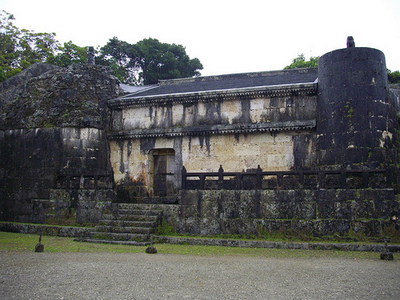Tamaudun
- Japanese: 玉陵 (Tamaudun)
Tamaudun is the royal mausoleum of the Ryûkyû Kingdom. It was originally built in 1501 by King Shô Shin to house the remains of his father, King Shô En.
The mausoleum is located a short distance to the west of Shuri castle, and has been designated a National Cultural Property and Historical Site,[1] as well as being included alongside Shuri and other gusuku (Okinawan castles) in the 'Gusuku Sites and Related Properties of the Kingdom of Ryukyu' World Heritage Site.[2] The compound consists of three chambers in one large stone building carved directly into the limestone bedrock, located behind two courtyards encircled by stone walls. A pair of guardian statues stand atop the structure.
The kings and queens of the Ryûkyû Kingdom are entombed in the eastern chamber, along with a number of crown princes and princesses. Other members of the royal family are entombed in the western chamber, while the central chamber was not intended for permanent entombment, though a single funerary urn containing an unidentified individual's remains does remain there. Rather, the central chamber was used for the senkotsu ritual. As in traditional Okinawan commoners' funerary ritual, after death a body was placed in the central chamber until all that remained was bones; the bones were then ritually washed, and placed in a funerary urn which would then be entombed permanently in the western or eastern chamber.
Following Tamaudun's completion, Shô En's remains were moved there from a site called Miagemori (見上森), where he had been originally entombed. Every King of Ryûkyû from Shô En onwards is entombed at Tamaudun, with one exception. Shô Nei (r. 1587-1620) requested to be buried elsewhere, allegedly because he felt he had dishonored his ancestors by allowing Ryûkyû to fall to Japanese invasion in 1609. Shô Nei was instead entombed at Urasoe yôdore alongside Eiso and two other 13th-14th century kings of Okinawa.
Crown Prince Shô Ten was the last person to be entombed in Tamaudun, in 1920.
The compound took considerable damage in the 1945 battle of Okinawa, but survived mostly intact. The structure survives today, though the stone has been significantly blackened, not primarily by the bombing, but simply by age. Today, a visitor center near the entrance to the compound includes a small permanent exhibit gallery with models of the mausoleum, describing its history and layout.
References
- Plaques and museum displays on-site.
- ↑ Kadekawa Manabu 嘉手川学 (ed.). Okinawa Chanpurû jiten 沖縄チャンプルー事典. Yamakei Publishers, 2001. p56.
- ↑ "Gusuku Sites and Related Properties of the Kingdom of Ryukyu." UNESCO World Heritage Sites official website. 2012.
